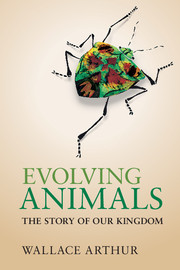Book contents
- Frontmatter
- Dedication
- Contents
- Preface
- Acknowledgements
- 1 What is an animal?
- 2 Before there were animals
- 3 How to make a fossil
- 4 The Cambrian explosion
- 5 How to make a species
- 6 Jellyfish and their kin
- 7 How to make a tree
- 8 The enigmatic urbilaterian
- 9 Animal symmetry and heads
- 10 A plethora of worms
- 11 Trends in animal complexity
- 12 Where the octopus is king
- 13 How to make an animal
- 14 Exoskeletons galore
- 15 Extinction
- 16 Mouth first, mouth second
- 17 Comparing embryos
- 18 Larvae, mouthparts and moulting
- 19 The animal toolkit
- 20 Vertebrate origins and evolution
- 21 From water to land to water
- 22 Variation and inheritance
- 23 Evolutionary novelties
- 24 Human origins and evolution
- 25 Animal plasticity
- 26 The nature of adaptation
- 27 The direction of evolution
- 28 Animal extremophiles
- 29 Extraterrestrial animals?
- 30 The ghost in the machine
- Appendix
- References
- Index
21 - From water to land to water
Published online by Cambridge University Press: 05 August 2014
- Frontmatter
- Dedication
- Contents
- Preface
- Acknowledgements
- 1 What is an animal?
- 2 Before there were animals
- 3 How to make a fossil
- 4 The Cambrian explosion
- 5 How to make a species
- 6 Jellyfish and their kin
- 7 How to make a tree
- 8 The enigmatic urbilaterian
- 9 Animal symmetry and heads
- 10 A plethora of worms
- 11 Trends in animal complexity
- 12 Where the octopus is king
- 13 How to make an animal
- 14 Exoskeletons galore
- 15 Extinction
- 16 Mouth first, mouth second
- 17 Comparing embryos
- 18 Larvae, mouthparts and moulting
- 19 The animal toolkit
- 20 Vertebrate origins and evolution
- 21 From water to land to water
- 22 Variation and inheritance
- 23 Evolutionary novelties
- 24 Human origins and evolution
- 25 Animal plasticity
- 26 The nature of adaptation
- 27 The direction of evolution
- 28 Animal extremophiles
- 29 Extraterrestrial animals?
- 30 The ghost in the machine
- Appendix
- References
- Index
Summary
Unlike arthropods, several groups of which invaded the land independently, vertebrates invaded the land just once in the course of evolution. Thus the group of land vertebrates – the tetrapods – is a monophyletic one. Much research has gone into the question of how, and when, this invasion took place, and as a result we now have a reasonably good idea of the answers to both the ‘how?’ and the ‘when?’ questions. One of the main features that changed in the vertebrate animals that invaded the land was the nature of their appendages: from the fins that help to power fishes through water to the legs that we and most of our fellow tetrapods use to walk on solid ground. So the invasion of the land by vertebrates is sometimes equated with the fin-to-limb transition – though strictly speaking these two things are not exactly the same, and they may not have occurred at exactly the same time as each other, as we’ll see.
Another of the main changes that occurred in the vertebrates that invaded the land was a shift from breathing in water to breathing in air. So we could also refer to the gill-to-lung transition, though this phrase is less often used. There is an interesting difference between the two transitions, which becomes apparent when terrestrial vertebrates go back to the water, as in the case of whales, in relation to their reversibility. Fins can be re-evolved quite easily, it seems. In contrast, it appears to be much more difficult, perhaps even impossible, to re-evolve gills.
- Type
- Chapter
- Information
- Evolving AnimalsThe Story of our Kingdom, pp. 212 - 221Publisher: Cambridge University PressPrint publication year: 2014



